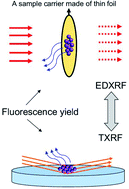Improvement of limit of detection sensitivities in the parts per billion range using conventional geometry synchrotron radiation excited EDXRF measurements
Abstract
Energy dispersive X-ray fluorescence (EDXRF) is a widely used non-destructive technique for micro and trace multi-element analysis of materials. Conventional trials show that using laboratory assisted EDXRF measurements, one can obtain elemental detection limits in the range of μg g−1 to sub-μg g−1 levels. In the present work a quantitative approach has been followed in attempting to explore how it is possible to obtain elemental detection limits in the range of ng g−1 by using simple EDXRF excitation (45°–45° geometry) instead of using the total reflection X-ray fluorescence (TXRF) technique, which renders relatively superior detection limits for different elements. In order to validate our method, we recorded the EDXRF spectrum from different standard reference samples under similar experimental conditions. The results reveal that by employing thin Kapton foil as a sample carrier with a thickness ranging between 25 and 50 μm and placing a very small quantity of the analyte mass on top of it, the EDXRF technique may offer comparable elemental detection limits to the TXRF technique.



 Please wait while we load your content...
Please wait while we load your content...